
Willows, also called sallows and osiers, of the genus Salix, comprise around 350 species of typically deciduous trees and shrubs, found primarily on moist soils in cold and temperate regions.
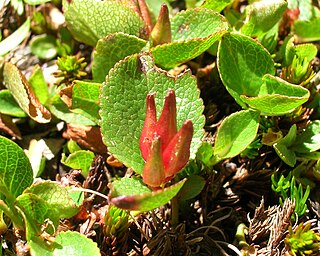
Salix herbacea, the dwarf willow, least willow or snowbed willow, is a species of tiny creeping willow adapted to survive in harsh arctic and subarctic environments. Distributed widely in alpine and arctic environments around the North Atlantic Ocean, it is one of the smallest of woody plants.
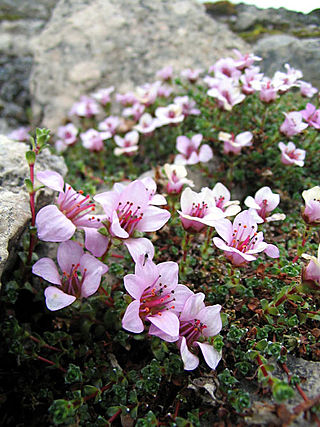
Saxifraga oppositifolia, the purple saxifrage or purple mountain saxifrage, is a species of plant that is very common in the high Arctic and also some high mountainous areas further south, including northern Britain, the Alps and the Rocky Mountains.

Salix polaris, the polar willow, is a species of willow with a circumpolar distribution in the high arctic tundra, extending north to the limits of land, and south of the Arctic in the mountains of Norway, the northern Ural Mountains, the northern Altay Mountains, Kamchatka, and British Columbia, Canada.
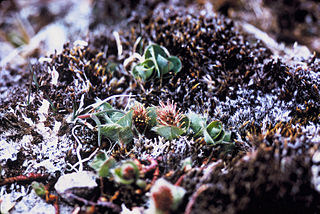
Salix arctica, the Arctic willow, is a tiny creeping willow. It is adapted to survive in Arctic conditions, specifically tundras.

Salix delnortensis is a species of willow known by the common name Del Norte willow.

Salix lanata, the woolly willow, is a subarctic species of willow native to Iceland, the Faeroe Islands and Finland, through to eastern Siberia. In Scotland it can be found in only a few localities of Perthshire, Angus and Aberdeenshire, generally on rocky mountain sides at altitudes of 600–900 m (1,969–2,953 ft).
Salix barrattiana is a species of flowering plant in the willow family known by the common name Barratt's willow. It is native to North America, where it is distributed across Alaska and western Canada, with also a few populations in Montana and Wyoming. These disjunct populations are probably relics from a time when the climate was colder. The southernmost population is technically in Wyoming, but it is located at the Montana state line and it is limited to one clone of all-staminate plants within an area of 100 square meters (1,100 sq ft) in a high-elevation habitat.

Gynaephora groenlandica, the Arctic woolly bear moth, is an erebid moth native to the High Arctic in the Canadian archipelago, Greenland and Wrangel Island in Russia. It is known for its slow rate of development, as its full caterpillar life cycle may extend up to 7 years, with moulting occurring each spring. This species remains in a larval state for the vast majority of its life. Rare among Lepidoptera, it undergoes an annual period of diapause that lasts for much of the calendar year, as G. groenlandica is subject to some of the longest, most extreme winters on Earth. In this dormant state, it can withstand temperatures as low as −70 °C. The Arctic woolly bear moth also exhibits basking behavior, which aids in temperature regulation and digestion and affects both metabolism and oxygen consumption. Females generally do not fly, while males usually do.

Salix bebbiana is a species of willow indigenous to Canada and the northern United States, from Alaska and Yukon south to California and Arizona and northeast to Newfoundland and New England. Common names include beaked willow, long-beaked willow, gray willow, and Bebb's willow. This species is also called red willow by Native Americans according to The Arctic Prairies Appendix E by Ernest Tompson Seton.

Salix sitchensis is a species of willow known by the common name Sitka willow.

Salix alaxensis is a species of flowering plant in the willow family known by the common names Alaska willow and feltleaf willow. It is native to northern North America, where it occurs throughout Alaska and northwestern Canada.

Salix brachycarpa is a species of flowering plant in the willow family known by the common names barren-ground willow, small-fruit willow and shortfruit willow.

Salix hastata is a species of flowering plant in the willow family, known by the common name halberd willow. It has an almost circumpolar distribution, occurring throughout the northern latitudes of the Northern Hemisphere, most frequently found near the coast of the Arctic Ocean. In Alaska, it occurs in the north and in the central mountains. It also occurs in northwestern Canada, and in Norway and Russia, as well as various alpine or mountainous areas of Eurasia.
Salix monticola is a species of flowering plant in the willow family known by the common names mountain willow, cherry willow, serviceberry willow, and park willow. It is native to the United States, where it occurs in the Rocky Mountains region from Wyoming to Arizona and New Mexico. It also occurs in Alaska and parts of Canada.
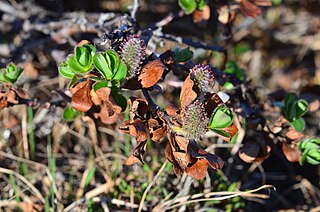
Salix pulchra is a species of flowering plant in the willow family, known by the common names diamondleaf willow, tealeaf willow, and thin red willow. It is native to northern North America, where it occurs in Alaska, Yukon, the Northwest Territories, and Nunavut. The species is also found in northern British Columbia, and occurs in Russia.

Salix richardsonii is a species of flowering plant in the Salicaceae, or willow family. It is known by the common names Richardson's willow and woolly willow. It is native to Russia and northern North America, where it occurs in Alaska and northern Canada. Some authorities consider it to be a subspecies, Salix lanata subsp. richardsonii(Hook.) A. K. Skvortsov rather than a species itself.
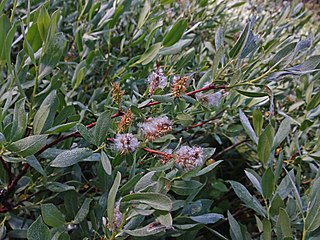
Salix wolfi, or Wolf's willow, is a species of willow native to western United States, from north-central Montana and central Oregon to northern New Mexico.

Salix vestita, the rock willow, is a small shrub in the willow genus (Salix).
Salix turnorii, also known as Turnor's willow, is a species of willow. It is endemic to the Athabasca Sand Dunes Provincial Park in Saskatchewan, Canada. It is listed as imperiled by NatureServe.
















